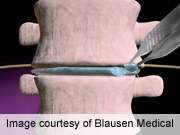An independent Clinical Effects Committee can improve the accuracy of investigational device-related adverse event assessment, according to a study published in the Aug. 21 issue of The Journal of Bone & Joint Surgery.
(HealthDay)—An independent Clinical Effects Committee (CEC) can improve the accuracy of investigational device-related adverse event assessment, according to a study published in the Aug. 21 issue of The Journal of Bone & Joint Surgery.
Joshua D. Auerbach, M.D., from Bronx-Lebanon Hospital Center in New York, and colleagues classified the severity of adverse events and their relationship to the surgery and device for participants in a randomized controlled trial comparing coflex (Paradigm Spine) stabilization with lumbar spinal fusion for treatment of spinal stenosis and spondylolisthesis. Adverse event reports were reviewed and reclassified by an independent CEC comprising three spine surgeons without affiliation to the study sponsor.
The researchers found that in 37.3 percent of the 1,055 reported adverse events the CEC reclassified the level of severity, relation to the surgery, and/or relation to the device. Reclassification occurred in a similar proportion of cases in the coflex and fusion groups (P = 0.56). The CEC was significantly more likely to upgrade than downgrade the adverse event (odds ratio, 5.3); the relationship to the surgery (odds ratio, 7.3); and the relationship to the device (odds ratio, 11.6). Reclassification was not significantly affected by the status of the investigator's financial interest in the company.
"An independent CEC can identify and mitigate potential inherent investigator bias and facilitate an accurate assessment of the safety profile of an investigational device," the authors write.
One or more authors disclosed financial ties an entity in the biomedical arena.
More information:
Abstract
Full Text (subscription or payment may be required)
Editorial
Copyright © 2013 HealthDay. All rights reserved.
























